Noise and Vibration Analysis of Electric Oil Pump with Asymmetric Pitch Control for Gearbox in Hybrid and Battery Electric Vehicle
Abstract
1. Introduction
2. Pump Geometry and Asymmetric Pitch
2.1. Asymmetric Pitch of Vane-Type Oil Pump
2.2. Shape of Gear-Type Oil Pump
3. Asymmetric Pitch Control
3.1. Control of Permanent Magnet Synchronous Motor
3.2. Design of Asymmetric Pitch Control
4. Experimental Results
4.1. Pump-Level Test Results
4.2. Gearbox-Level Test Results
5. Conclusions
Funding
Institutional Review Board Statement
Informed Consent Statement
Data Availability Statement
Conflicts of Interest
References
- Lequesne, B. Automotive Electrification: The Nonhybrid Story. IEEE Trans. Transp. Electrif. 2015, 1, 40–53. [Google Scholar] [CrossRef]
- Liu, Y.; Zhou, Y.; Wang, J.; Qu, D.; Zhang, F. Hydraulic System Control for a Hybrid Continuously Variable Transmission Based on an Electric Oil Pump. IEEE Trans. Veh. Technol. 2018, 67, 10398–10410. [Google Scholar] [CrossRef]
- Beik, O. Design Optimization of a PM Motor: A Practical Approach for Mass Production. IEEE Trans. Energy Convers. 2020, 35, 1849–1858. [Google Scholar] [CrossRef]
- Taekwan, S. Analytical Study on Inner Flow and Structural Stiffness in Vane Type of Vacuum Pump. Trans. Korean Soc. Automot. Eng. 2017, 25, 201–206. [Google Scholar] [CrossRef]
- Jang, J.-W.; Hwang, Y.-T.; Choi, Y.-S.; Lee, K.-Y.; Jeong, U.-H.; Seiji, M. Random Pitch Impeller for Fuel Pump. U.S. Patent US8092186B2, 10 January 2012. [Google Scholar]
- Lee, K.-Y.; Jung, U.-H.; Kim, J.-H.; Kim, C.-H.; Choi, Y.-S.; Ma, J.-H.; Jeong, K.-H.; Park, W.-J. Analysis of Noise Characteristic of Uneven Pitch Regenerative Blower. KSFM J. Fluid Mach. 2015, 18, 71–75. [Google Scholar] [CrossRef]
- Zheng, Y.; Jin, X.; Yang, H. Effects of Asymmetric Vane Pitch on Reducing Low-Engine-Order Forced Response of a Turbine Stage. Aerospace 2022, 9, 694. [Google Scholar] [CrossRef]
- Stuppioni, U.; Natali, C.; Battarra, M.; Blum, A.; Suman, A.; Pinelli, M.; Dalpiaz, G.; Mucchi, E. Experimental and numerical characterization of the under-vane pressure in balanced vane pumps. Results Eng. 2024, 23, 102439. [Google Scholar] [CrossRef]
- Mistry, Z.; Vacca, A.; Uppaluri, S.K. Modeling and experimental validation of twin lip balanced vane pump considering micromotions, contact mechanics, and lubricating interfaces. Simul. Model. Pract. Theory 2024, 133, 102914. [Google Scholar] [CrossRef]
- Mitov, A.; Nedelchev, K.; Kralov, I. Experimental Study of Sound Pressure Level in Hydraulic Power Unit with External Gear Pump. Processes 2023, 11, 2399. [Google Scholar] [CrossRef]
- Wang, S.; Wang, H.; Li, G.; Li, T. Numerical Simulation Study on Cavitation Characteristics of Circular Arc Spiral Gear Pump at High Speed. Appl. Sci. 2025, 15, 3141. [Google Scholar] [CrossRef]
- Shen, H.; Li, Z.; Qi, L.; Qiao, L. A method for gear fatigue life prediction considering the internal flow field of the gear pump. Mech. Syst. Signal Process. 2018, 99, 921–929. [Google Scholar] [CrossRef]
- Mitov, A.; Nikolov, N.; Nedelchev, K.; Kralov, I. CFD Modeling and Experimental Validation of the Flow Processes of an External Gear Pump. Processes 2024, 12, 261. [Google Scholar] [CrossRef]
- Xu, B.; Liu, Q.; Zhu, Z.; Gao, Y.; Li, C.; Zhang, Y. Influence of the Rotation Speed on the Internal Flow Characteristics of an Aircraft Fuel Gear Pump. Processes 2024, 12, 576. [Google Scholar] [CrossRef]
- Huang, P.; Xu, L.; Luo, C.; Zhang, J.; Chi, F.; Zhang, Q.; Zhou, J. A Study on Noise Reduction of Gear Pumps of Wheel Loaders Based on the ICA Model. Int. J. Environ. Res. Public Health 2019, 16, 999. [Google Scholar] [CrossRef] [PubMed]
- Natali, C.; Stuppioni, U.; Battarra, M.; Blum, A.; Dalpiaz, G.; Mucchi, E. A novel experimental method for measuring oil film thickness in balanced vane pumps. Measurement 2024, 227, 114254. [Google Scholar] [CrossRef]
- Rundo, M.; Corvaglia, A. Lumped Parameters Model of a Crescent Pump. Energies 2016, 9, 876. [Google Scholar] [CrossRef]
- Ivanović, L.; Josifović, D.; Ilic, A.; Stojanovic, B. Analytical model of the pressure variation in the gerotor pump chambers. Tech. Technol. Educ. Manag. 2013, 8, 323–331. [Google Scholar]
- Choi, C.; Lee, W. Extended Digital Programmable Low-Pass Filter for Direct Noise Filtering of Three-Phase Variables in Low-Cost AC Drives. Energies 2022, 15, 2096. [Google Scholar] [CrossRef]
- Choi, C.; Kim, J. Model-Based Angular Position Sensorless Drives of Main Electric Oil Pumps for e-Axles in HEV and BEV. Energies 2024, 17, 4962. [Google Scholar] [CrossRef]
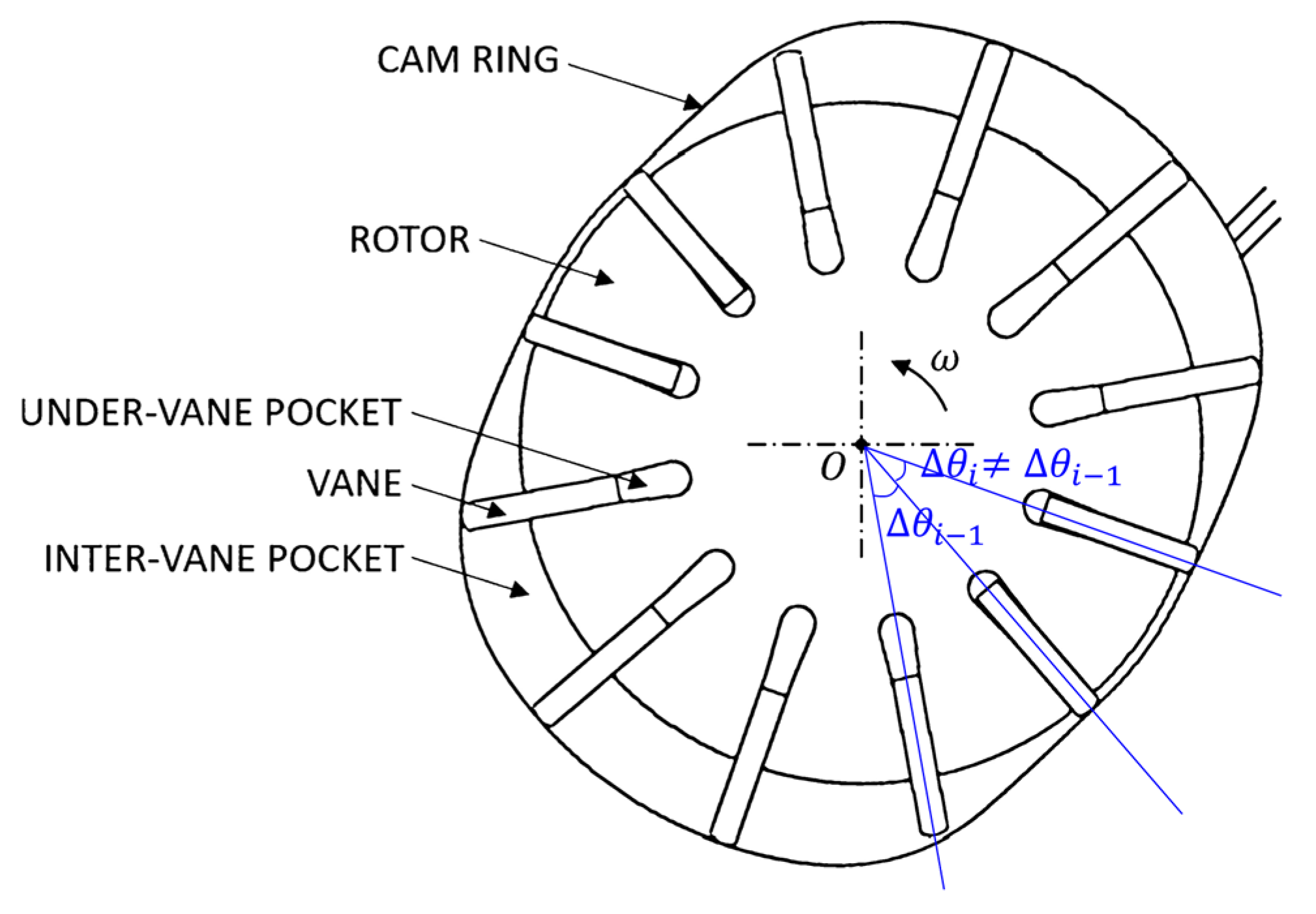
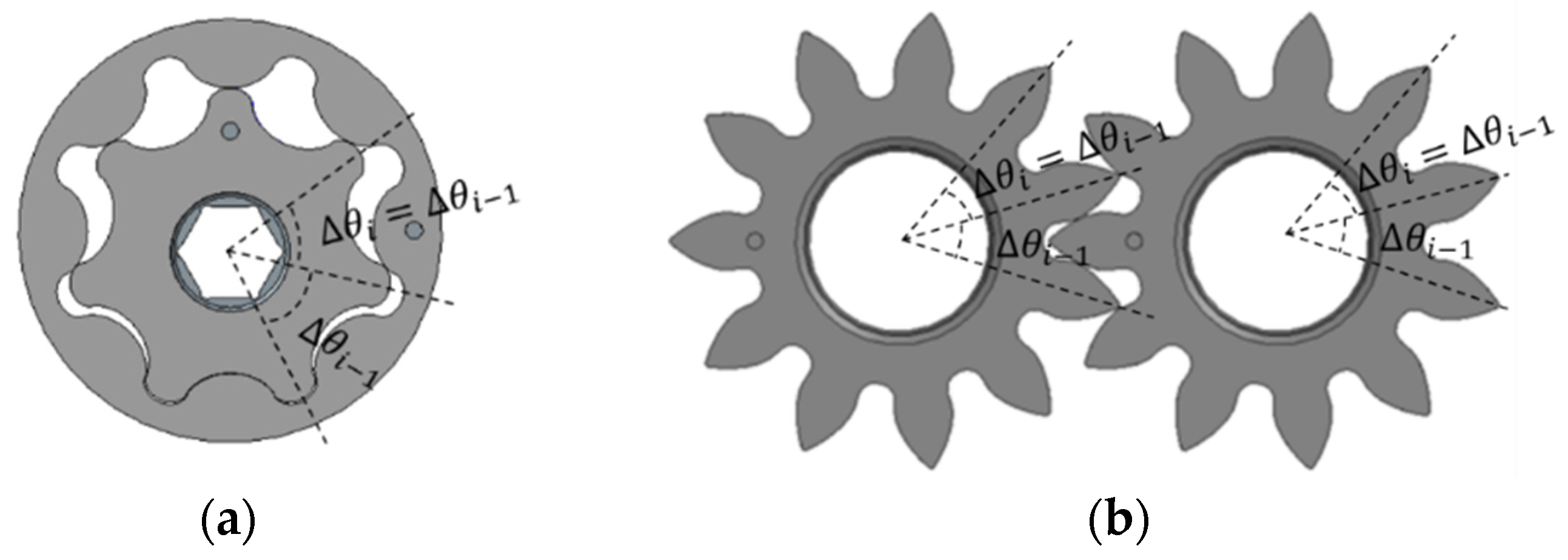
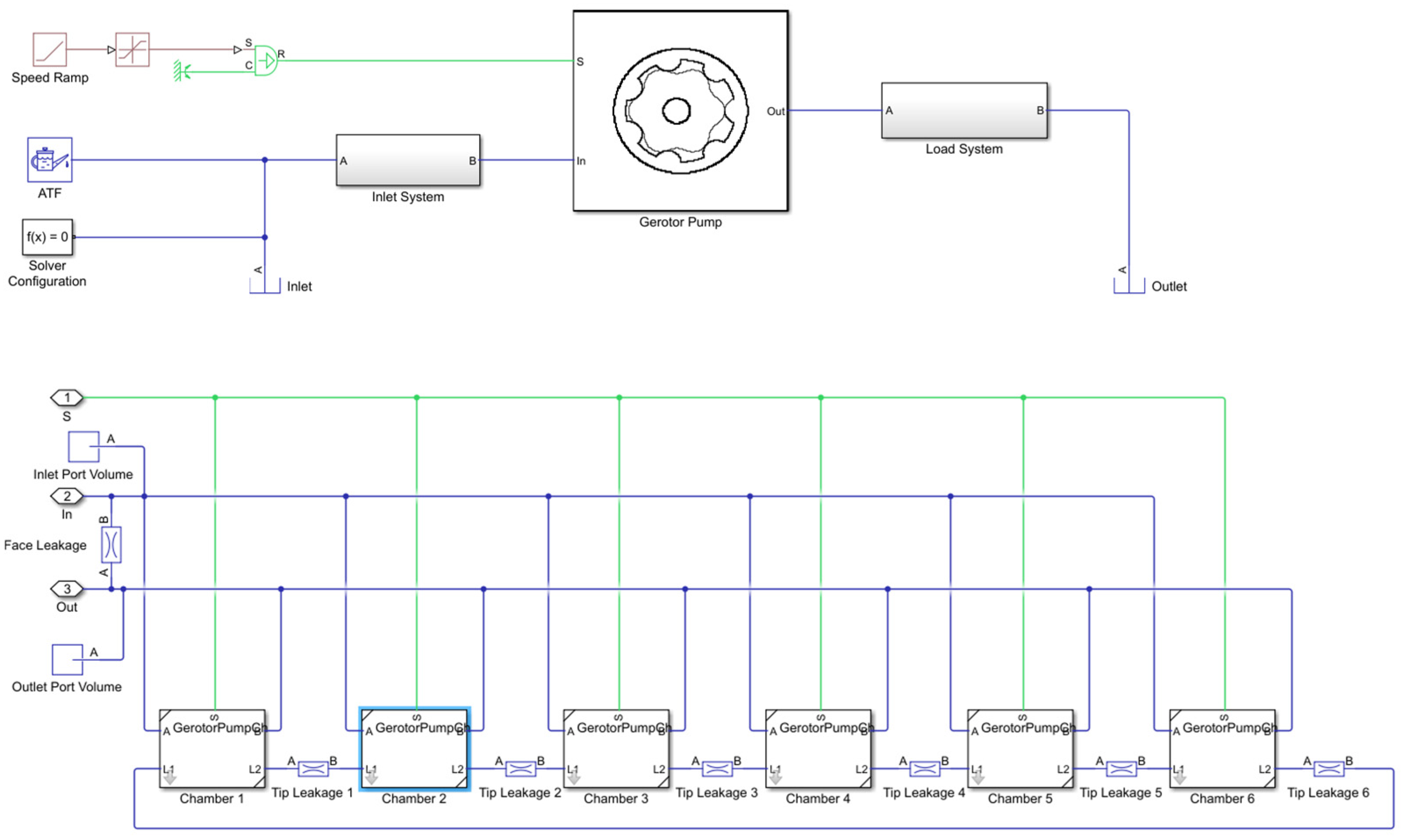

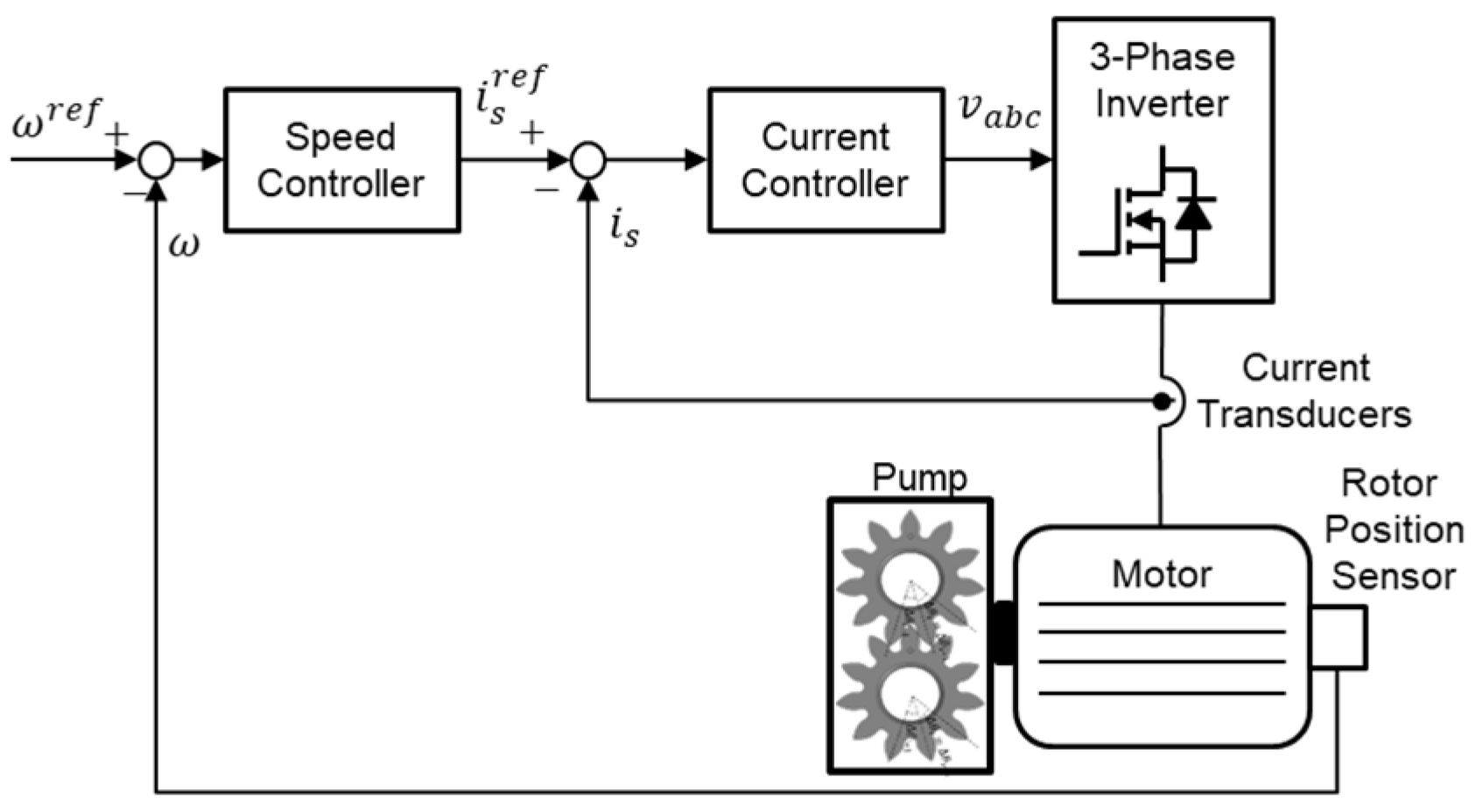
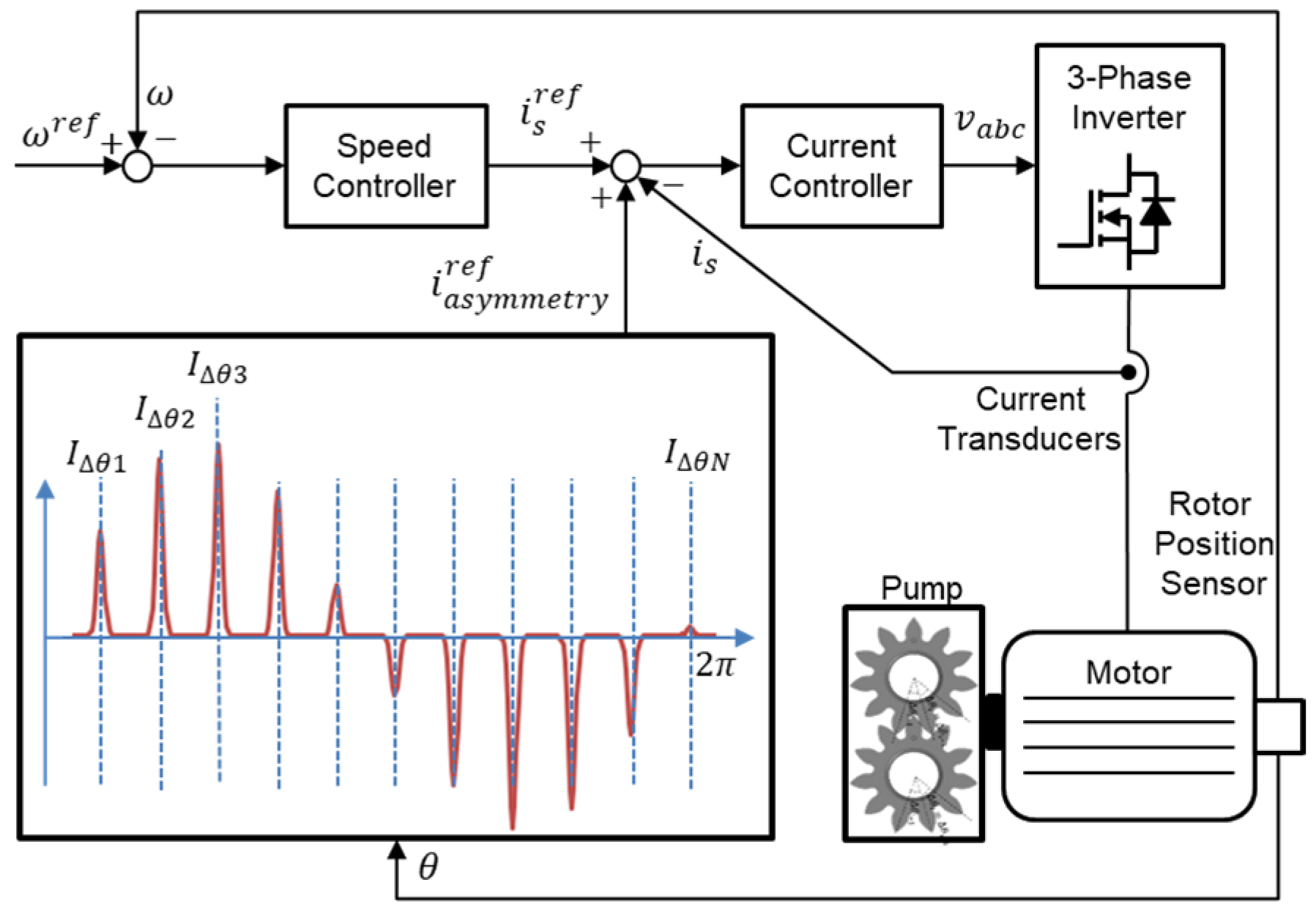
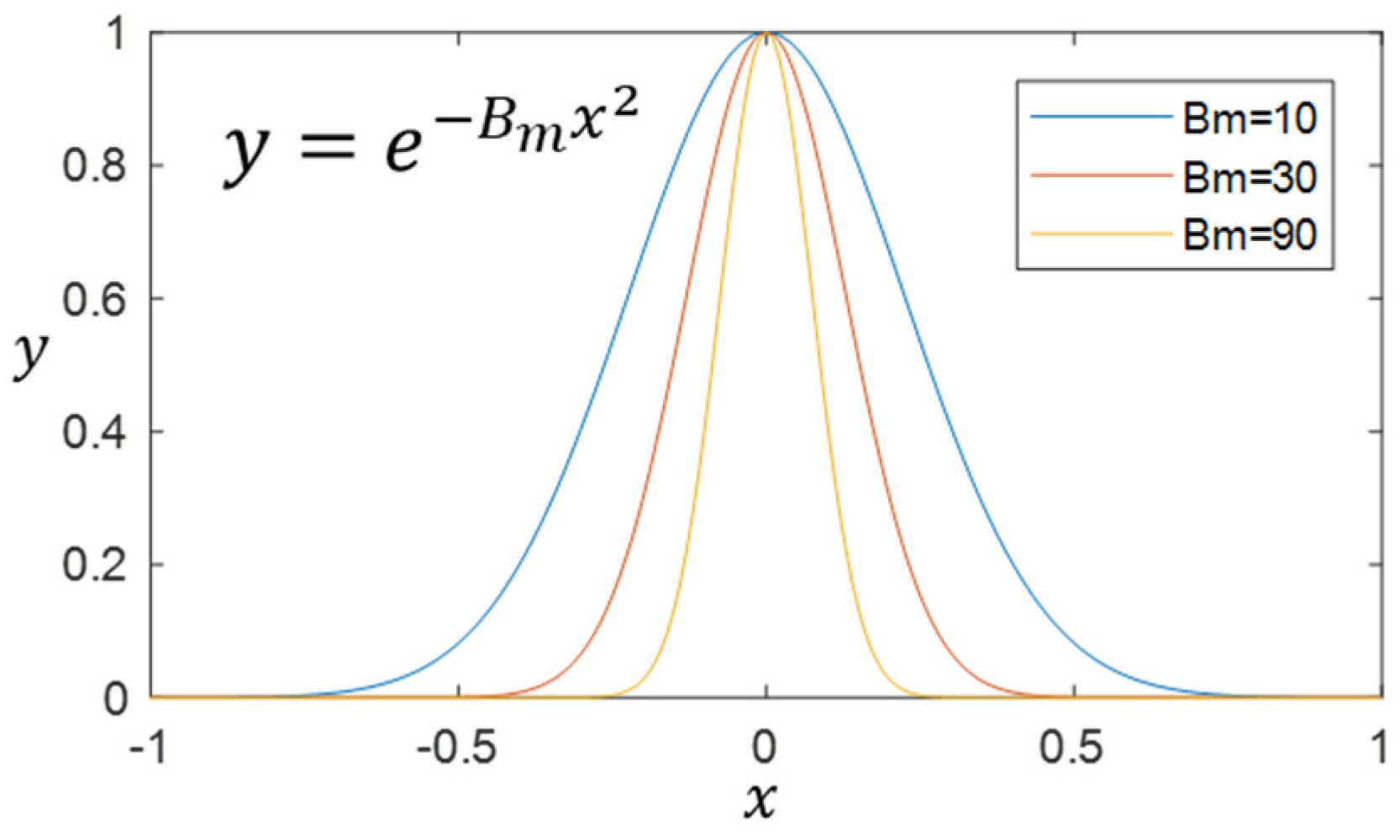
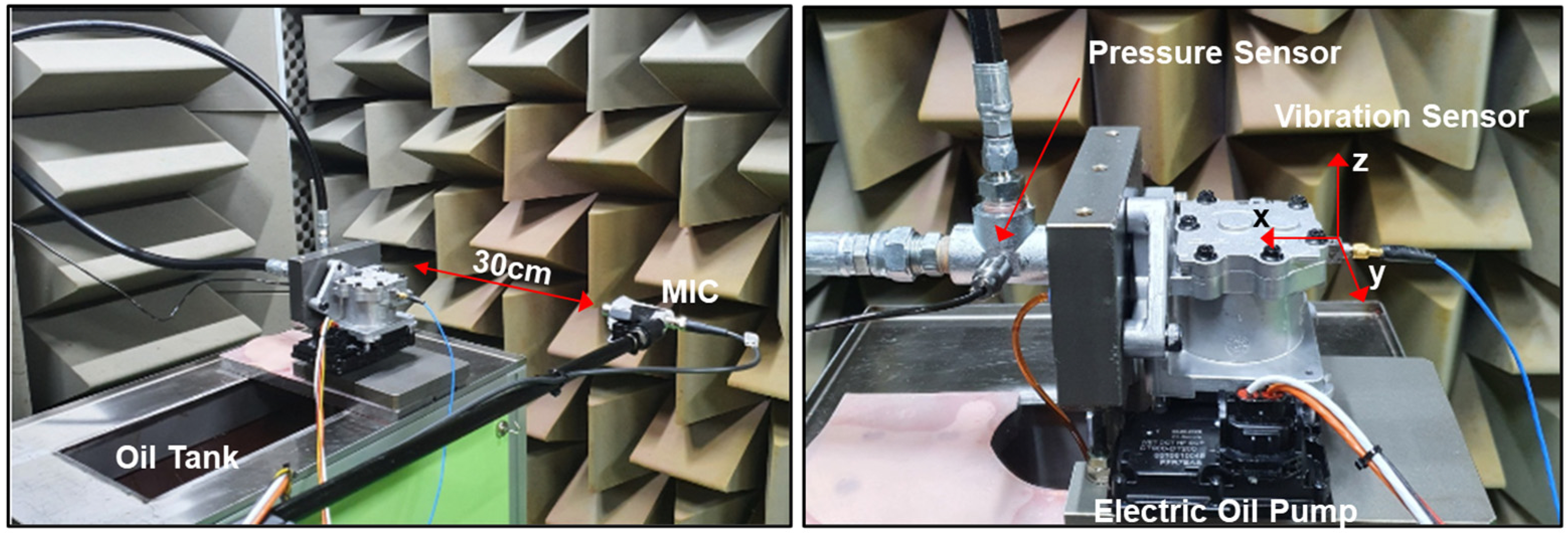
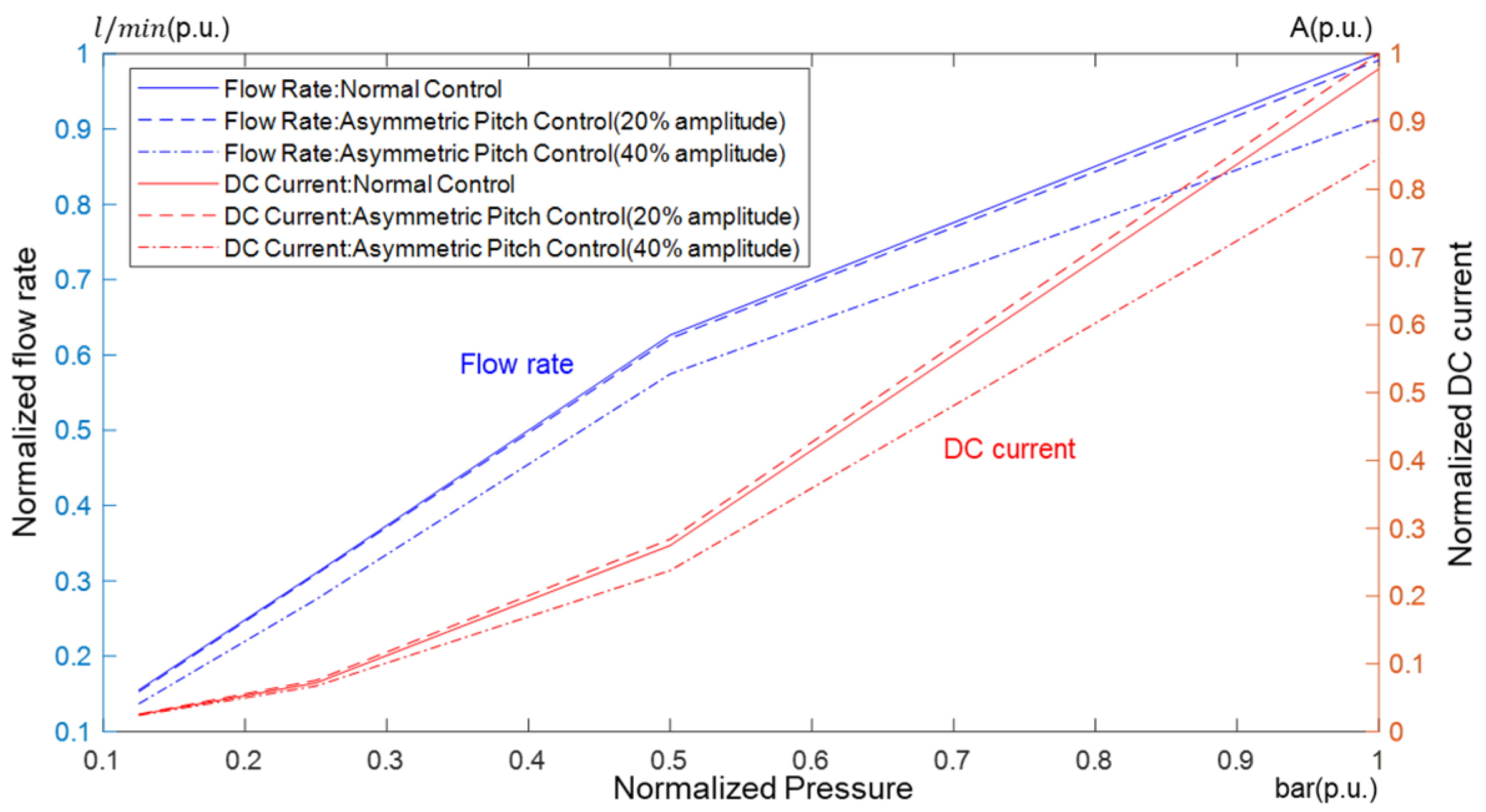
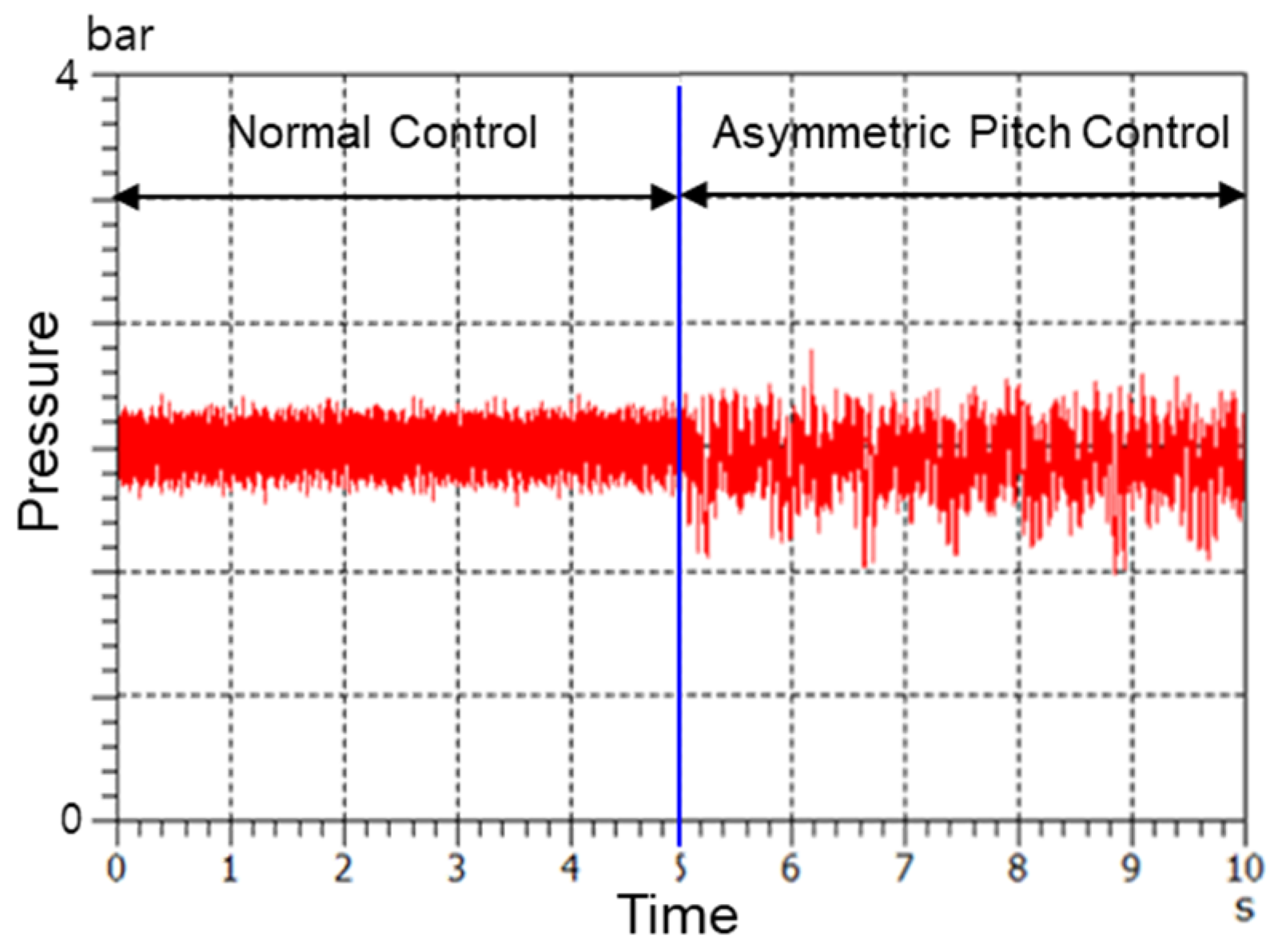


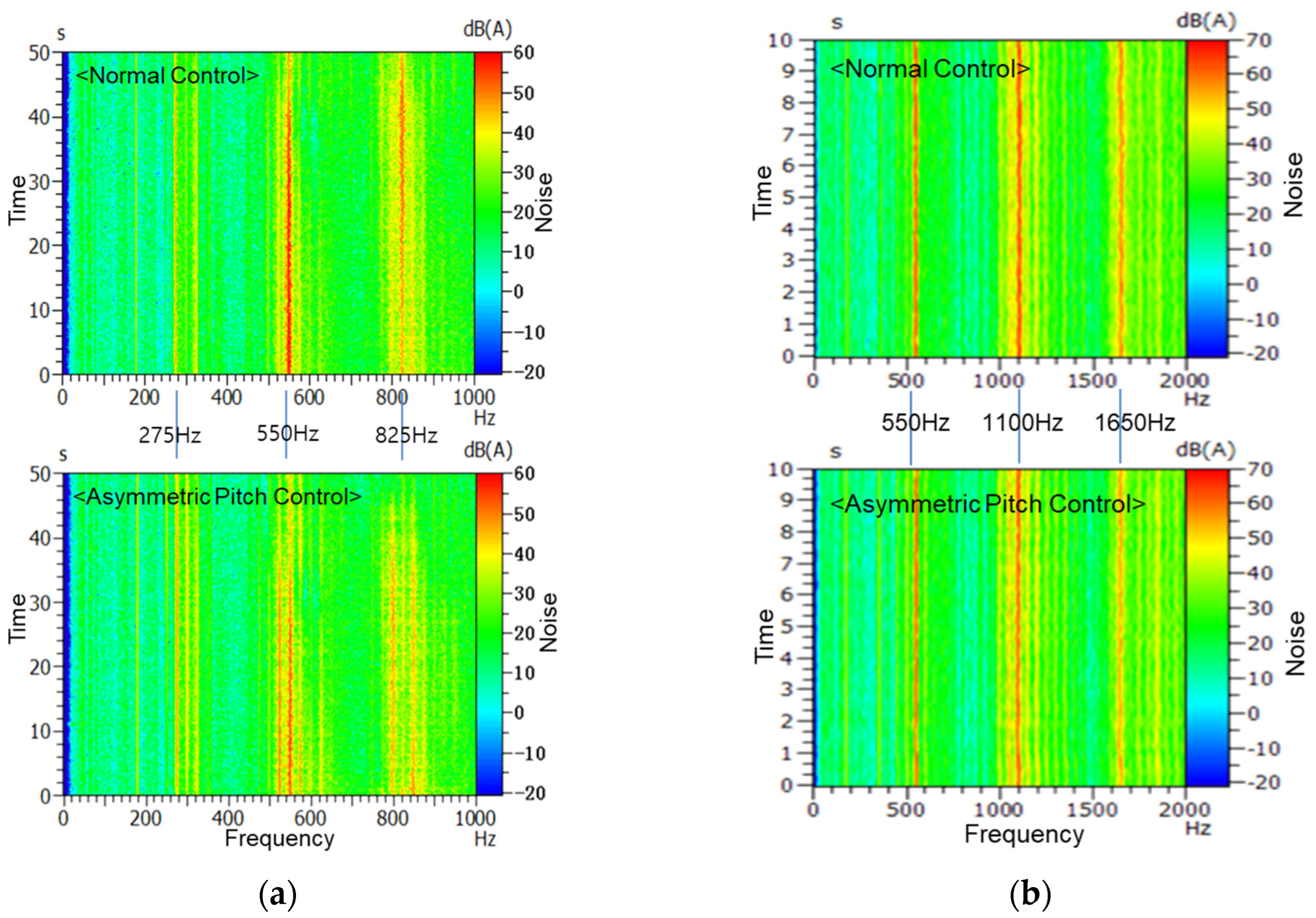
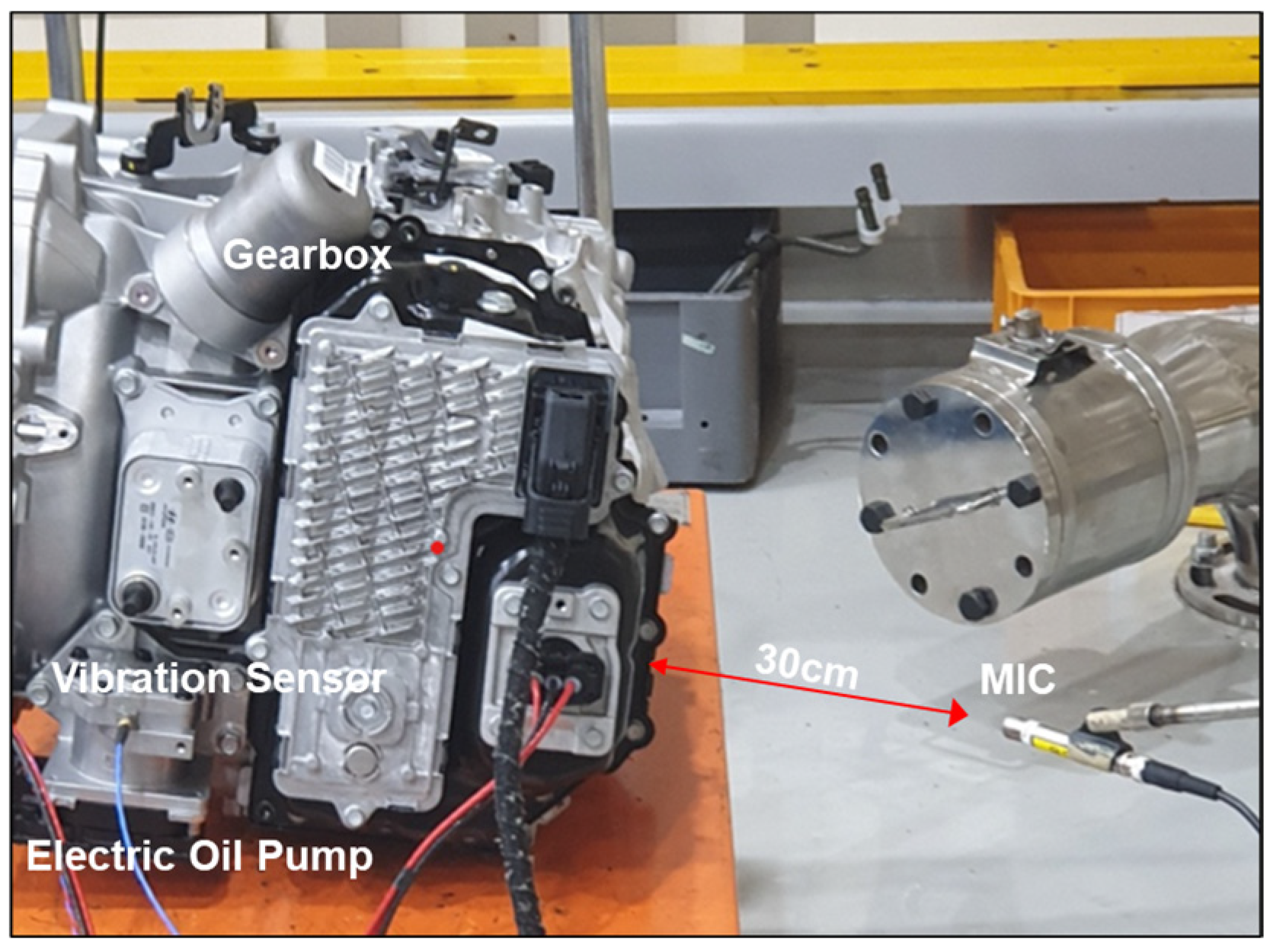
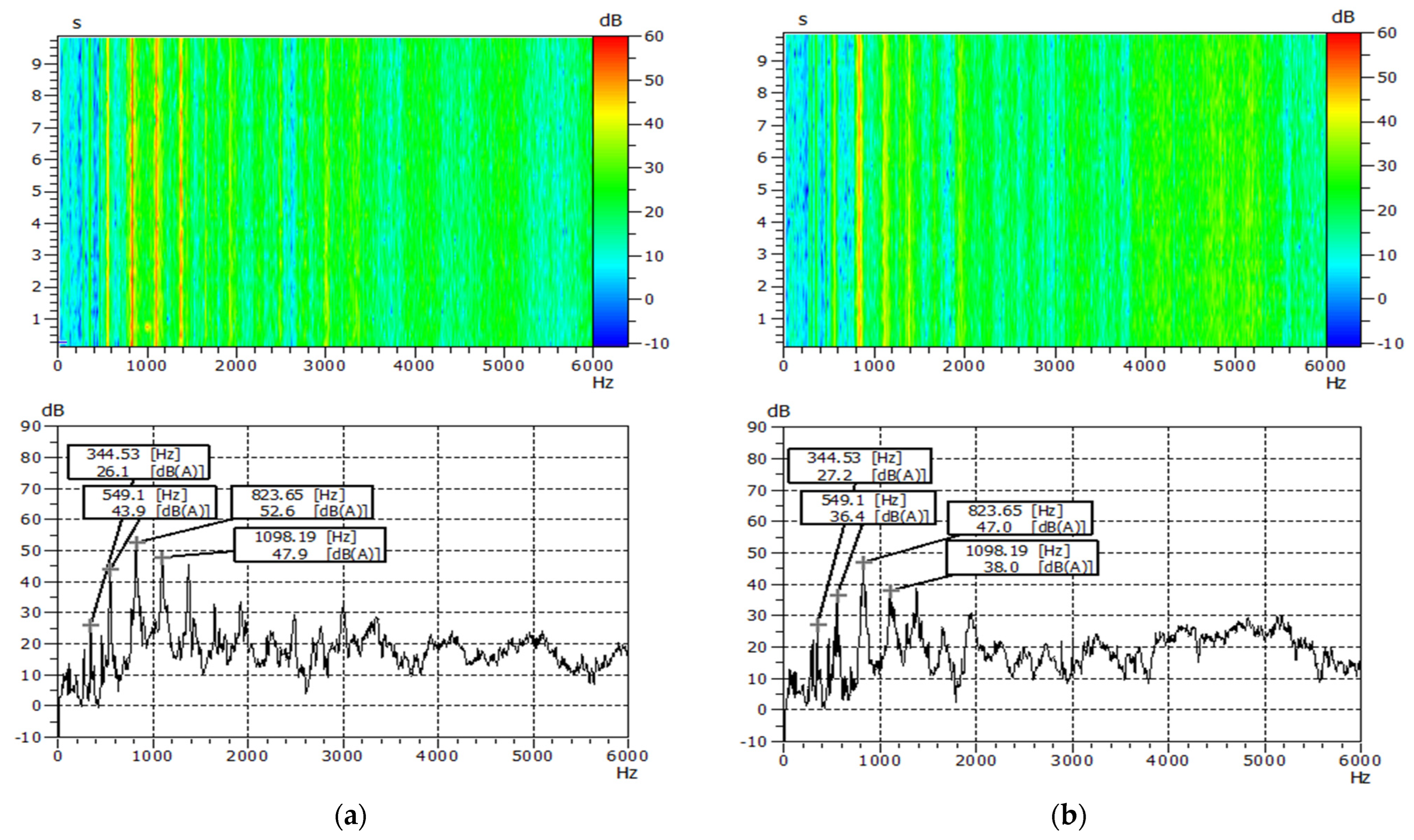
| Specifications | Value | Unit |
|---|---|---|
| Pump Type | External | - |
| Number of Teeth | 11 | EA |
| Max Operating Speed | 3200 | RPM |
| Max Hydraulic Pressure | 4 | Bar |
| Max Hydraulic Flow Rate | 16 | lpm |
| Max Electric Power | 400 | W |
| Control Parameters | Value | Unit |
|---|---|---|
| Microcontroller | Infineon TC212 | - |
| Execution Period (PWM Period) | 50 | μs |
| Bandwidth of the Current Controller | 300 | Hz |
| Proportional Gain | 0.002512 | - |
| Integral Gain | 0.1256 | - |
| DC Voltage | 12 | V |
| Category | Noise [dB(A)] | Vibration [dB] | ||
|---|---|---|---|---|
| Overall | Max Peak | Overall | Max Peak | |
| Normal Control | 58.2 | 52.0 | 134.0 | 118.1 |
| Asymmetric Pitch Control | 58.0 | 47.5 | 133.5 | 113.9 |
| Category | Noise [dB(A)] | |
|---|---|---|
| Overall | Max Peak | |
| Normal Control | 58.3 | 52.6 |
| Asymmetric Pitch Control | 57.4 | 47.0 |
Disclaimer/Publisher’s Note: The statements, opinions and data contained in all publications are solely those of the individual author(s) and contributor(s) and not of MDPI and/or the editor(s). MDPI and/or the editor(s) disclaim responsibility for any injury to people or property resulting from any ideas, methods, instructions or products referred to in the content. |
© 2025 by the author. Licensee MDPI, Basel, Switzerland. This article is an open access article distributed under the terms and conditions of the Creative Commons Attribution (CC BY) license (https://creativecommons.org/licenses/by/4.0/).
Share and Cite
Choi, C. Noise and Vibration Analysis of Electric Oil Pump with Asymmetric Pitch Control for Gearbox in Hybrid and Battery Electric Vehicle. Appl. Sci. 2025, 15, 5779. https://doi.org/10.3390/app15105779
Choi C. Noise and Vibration Analysis of Electric Oil Pump with Asymmetric Pitch Control for Gearbox in Hybrid and Battery Electric Vehicle. Applied Sciences. 2025; 15(10):5779. https://doi.org/10.3390/app15105779
Chicago/Turabian StyleChoi, Chinchul. 2025. "Noise and Vibration Analysis of Electric Oil Pump with Asymmetric Pitch Control for Gearbox in Hybrid and Battery Electric Vehicle" Applied Sciences 15, no. 10: 5779. https://doi.org/10.3390/app15105779
APA StyleChoi, C. (2025). Noise and Vibration Analysis of Electric Oil Pump with Asymmetric Pitch Control for Gearbox in Hybrid and Battery Electric Vehicle. Applied Sciences, 15(10), 5779. https://doi.org/10.3390/app15105779






